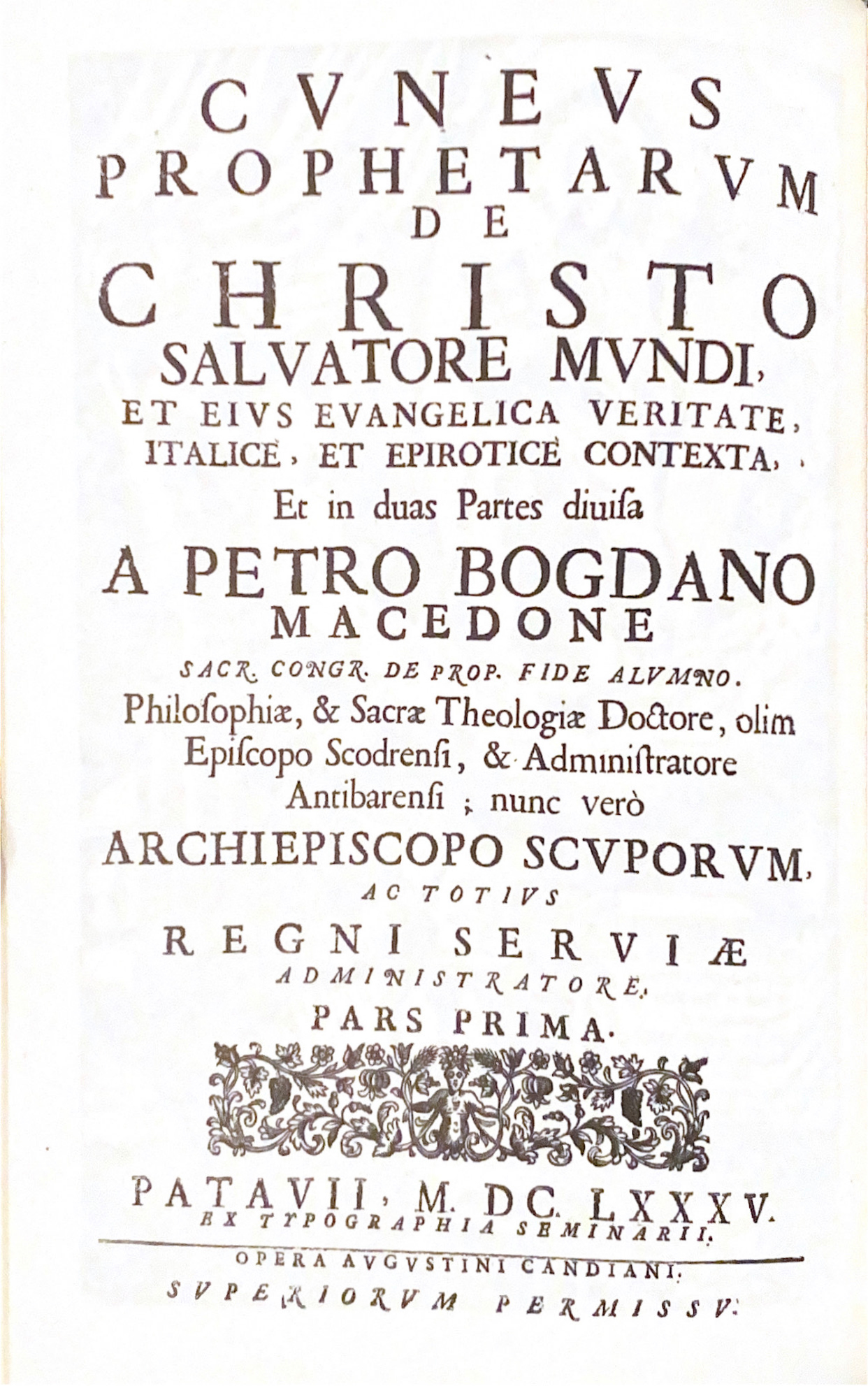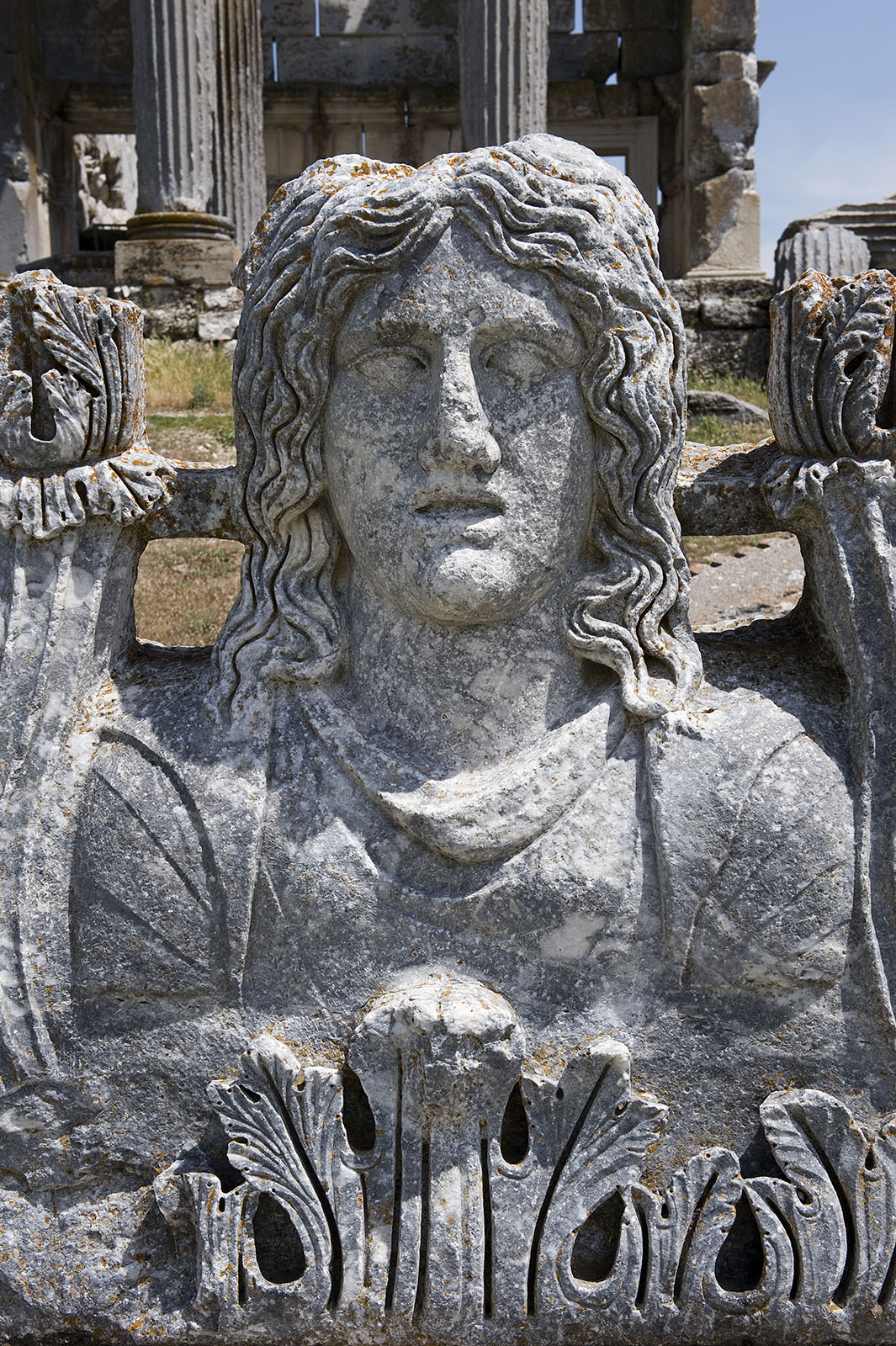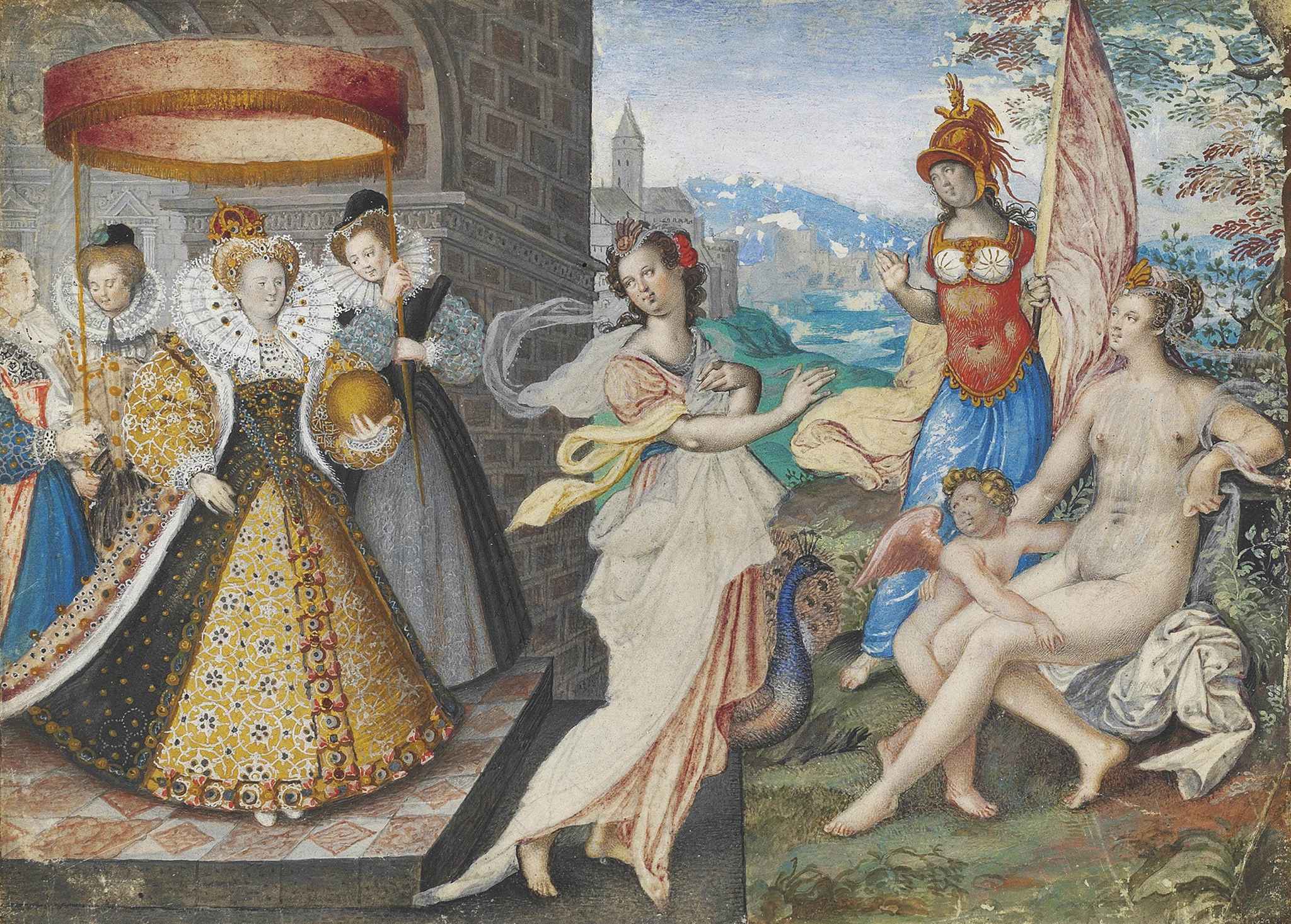|
Cuneus Prophetarum
''Cuneus Prophetarum'' (, ) is a philosophical, theological and scientific treatise written by Pjetër Bogdani, an Albanian philosopher, originally published in Padua in 1685 in Albanian and Latin. It is considered to be the most prominent work of early Albanian literature. History Pjetër Bogdani had finished writing ''Cuneus Prophetarum'' by 1675 but was refused the rights to publish it by the Sacred Congregation for the Propagation of the Faith that ordered its translation to allow the book's publication. After ten years the book was published with the assistance of Gregorio Barbarigo, cardinal of Padua in 1685 in Padua, Northern Italy. The original Latin title of the treatise is: Cuneus prophetarum de Christo salvatore mundi et eius evangelica veritate, italice et epirotice contexta, et in duas partes diuisa a Petro Bogdano Macedone, Sacr. Congr. de Prop. Fide alumno, Philosophiae & Sacrae Theologiae Doctore, olim Episcopo Scodrensi & Administratore Antibarensi, nunc ... [...More Info...] [...Related Items...] OR: [Wikipedia] [Google] [Baidu] |
Pjetër Bogdani
Pjetër Bogdani (; 1627 – 6 December 1689) was the most original writer of Old Albanian literature. He was author of the Cuneus Prophetarum (''The Band of the Prophets''), 1685, the first prose work of substance written originally in (Gheg) Albanian (i.e. not a translation). He organized a resistance against the Ottomans and a pro-Austrian movement in Kosovo in 1689 that included Muslim and Christian Albanians. Life and work He was born in the village of Gur in the area of Has, near Prizren in 1627. Its exact location is unknown, but Robert Elsie has proposed two modern day villages of Gjonaj and Breg Drini in Prizren area. Bogdani was educated in the traditions of the Catholic Church. His uncle Andrea Bogdani (c. 1600–1683) was Archbishop of Skopje and author of a Latin-Albanian grammar, now lost. His families surname Bogdani is an Albanian surname meaning 'son of Bogdan ‘. It is of Slavic origin and Bogdan in Slavic means "God-given". Bogdani is said to have rece ... [...More Info...] [...Related Items...] OR: [Wikipedia] [Google] [Baidu] |
Sibyls
The sibyls were prophetesses or oracles in Ancient Greece. The sibyls prophesied at holy sites. A sibyl at Delphi has been dated to as early as the eleventh century BC by PausaniasPausanias 10.12.1 when he described local traditions in his writings from the second century AD. At first, there appears to have been only a single sibyl. By the fourth century BC, there appear to have been at least three more, Phrygian, Erythraean, and Hellespontine. By the first century BC, there were at least ten sibyls, located in Greece, Italy, the Levant, and Asia Minor. History The English word ''sibyl'' () is from Middle English, via the Old French and the Latin">-4; we might wonder whether there's a point at which it's appropriate to talk of the beginnings of French, that is, when it wa ... and the Latin from the ancient Greek (). Varro derived the name from an Aeolic Greek, Aeolic ''sioboulla'', the equivalent of Attic ''theobule'' ("divine counsel"). This etymology is not accep ... [...More Info...] [...Related Items...] OR: [Wikipedia] [Google] [Baidu] |
Anton Santori
Francesco Antonio Santori ( Arbërisht: Françesk Anton Santori or Ndon Santori; September 16, 1819 – September 7, 1894) was an Arbëresh writer, poet and playwright. His play ''Emira'' is considered to be the first original Albanian drama ever written. The main character is a young and innocent girl who becomes a victim. Albanian literature of that time does not present many female characters like Emira. Life Santori was born on September 16, 1819, in Santa Caterina Albanese, an Arbëreshë town in the province of Cosenza, modern southern Italy. In 1835 at the age of sixteen he decided to become a priest and started his training for priesthood. In 1843 he entered the Franciscan monastery of the Reformed Order in San Marco Argentano. In 1858 he unsuccessfully tried to found a monastery in Lattarico, and in 1860 he abandoned monastic life. He continued living in Santa Caterina Albanese, where he worked as a teacher and a vendor of a spinning jenny he had constructed. In ... [...More Info...] [...Related Items...] OR: [Wikipedia] [Google] [Baidu] |
Divinity
Divinity (from Latin ) refers to the quality, presence, or nature of that which is divine—a term that, before the rise of monotheism, evoked a broad and dynamic field of sacred power. In the ancient world, divinity was not limited to a single deity or abstract ideal but was recognized in multiple forms: as a radiant attribute possessed by gods, as a vital force pervading nature, and even as a quality glimpsed in extraordinary humans, laws, or acts. The Latin and its Greek counterparts (, ) conveyed something both immanent and awe-inspiring: a presence that could be felt in thunder, justice, ecstasy, fate, or beauty. Among the Greeks and Romans, divinity was not confined to a rigid theological system. Gods, heroes, and even emperors might be described as partaking in divinity, just as natural forces or virtue could be seen as expressions of divine essence. Philosophers such as Plato and the Stoics used the term to refer to the soul of the cosmos or the rational order ... [...More Info...] [...Related Items...] OR: [Wikipedia] [Google] [Baidu] |
Early Modern Literature
The history of literature of the early modern period ( 16th, 17th and partly 18th century literature), or early modern literature, succeeds Medieval literature, and in Europe in particular Renaissance literature. In Europe, the Early Modern period lasts roughly from 1550 to 1750, spanning the Baroque period and ending with the Age of Enlightenment and the wars of the French Revolution. The Early Modern period in Persia corresponds to the rule of the Safavid dynasty. In Japan, the "Early Modern period" (Edo period) is taken to last down to 1868 (the beginning of Industrialization during the Meiji period). In India, the Mughal era lasts until the establishment of the British Raj in 1857. The Ottoman Empire underwent various attempts of modernization from 1828 ( Tanzimat). Chinese literature of the Qing dynasty remains mostly unaffected by European influence, and effects of modernization that would lead up to the New Culture Movement became apparent only from the Late Qing pe ... [...More Info...] [...Related Items...] OR: [Wikipedia] [Google] [Baidu] |
Humanism
Humanism is a philosophy, philosophical stance that emphasizes the individual and social potential, and Agency (philosophy), agency of human beings, whom it considers the starting point for serious moral and philosophical inquiry. The meaning of the term "humanism" has changed according to successive intellectual movements that have identified with it. During the Italian Renaissance, Italian scholars inspired by Greek classical scholarship gave rise to the Renaissance humanism movement. During the Age of Enlightenment, humanistic values were reinforced by advances in science and technology, giving confidence to humans in their exploration of the world. By the early 20th century, organizations dedicated to humanism flourished in Europe and the United States, and have since expanded worldwide. In the early 21st century, the term generally denotes a focus on human well-being and advocates for human freedom, autonomy, and progress. It views humanity as responsible for the prom ... [...More Info...] [...Related Items...] OR: [Wikipedia] [Google] [Baidu] |
Literary Theory
Literary theory is the systematic study of the nature of literature and of the methods for literary analysis. Culler 1997, p.1 Since the 19th century, literary scholarship includes literary theory and considerations of intellectual history, moral philosophy, social philosophy, and interdisciplinary themes relevant to how people interpret meaning. In the humanities in modern academia, the latter style of literary scholarship is an offshoot of post-structuralism. Searle, John. (1990)"The Storm Over the University" ''The New York Review of Books'', December 6, 1990. Consequently, the word ''theory'' became an umbrella term for scholarly approaches to reading texts, some of which are informed by strands of semiotics, cultural studies, philosophy of language, and continental philosophy, often witnessed within Western canon along with some postmodernist theory. History The practice of literary theory became a profession in the 20th century, but it has historical roots that ... [...More Info...] [...Related Items...] OR: [Wikipedia] [Google] [Baidu] |
Albanian Literature
Albanian literature stretches back to the Middle Ages and comprises those literary texts and works written in Albanian language, Albanian. It may also refer to literature written by Albanians in Albania, Kosovo and the Albanian diaspora particularly in Arbëreshë people, Italy. Albanian occupies an Isolated language, independent branch within the Indo-European languages, Indo-European family and does not have any other closely related language. The origin of Albanian is not entirely known, but it may be a successor of the ancient Illyrian languages, Illyrian language. The Archbishop of Antivari Guillaume Adam wrote a report in 1332 in which he said that Albanians used Latin letters in their books although their language was quite different from the Latin language. The oldest surviving documents written in Albanian are the "Formula e pagëzimit" (Baptismal formula) recorded by Pal Engjëlli, Bishop of Durrës in 1462 in the Gheg Albanian, Gheg dialect, and some New Testament ver ... [...More Info...] [...Related Items...] OR: [Wikipedia] [Google] [Baidu] |
Antichrist
In Christian eschatology, Antichrist (or in broader eschatology, Anti-Messiah) refers to a kind of entity prophesied by the Bible to oppose Jesus in Christianity, Jesus Christ and falsely substitute themselves as a savior in Christ's place before the Second Coming. The term ''Antichrist'' (including one plural form)First Epistle of John, 1 John ; . Second Epistle of John, 2 John . is found four times in the New Testament, solely in the First Epistle of John, First and Second Epistle of John. Antichrist is announced as one "who denies the Father and the Son." The similar term ''pseudokhristos'' or "false Christ" is also found in the Gospels. In Gospel of Matthew, Matthew (Matthew 24#Jesus predicts the destruction of the Temple, chapter 24) and Gospel of Mark, Mark (Mark 13, chapter 13), Jesus alerts his disciples not to be deceived by the False prophet#Christianity, false prophets, who will claim themselves to be the Christ (title), Christ, performing "great Sign#Christianity, signs ... [...More Info...] [...Related Items...] OR: [Wikipedia] [Google] [Baidu] |
Book Of Daniel
The Book of Daniel is a 2nd-century BC biblical apocalypse with a 6th-century BC setting. It is ostensibly a narrative detailing the experiences and Prophecy, prophetic visions of Daniel, a Jewish Babylonian captivity, exile in Babylon. The text features prophecy rooted in Jewish history as well as a eschatology, portrayal of the end times that is cosmic in scope and political in its focus. The message of the text intended for the original audience was that just as the Yahweh, God of Israel saves Daniel from his enemies, so too he would save the Israelites in their present oppression. The Hebrew Bible includes Daniel as one of the Ketuvim, while Christian biblical canons group the work with the major prophets. It divides into two parts: a set of six court tales in chapters 1–6, written mostly in Biblical Aramaic, and four apocalyptic visions in chapters 7–12, written mainly in Late Biblical Hebrew; the Septuagint, the earliest extant Greek translation of the Hebrew ... [...More Info...] [...Related Items...] OR: [Wikipedia] [Google] [Baidu] |
Second Coming
The Second Coming (sometimes called the Second Advent or the Parousia) is the Christianity, Christian and Islam, Islamic belief that Jesus, Jesus Christ will return to Earth after his Ascension of Jesus, ascension to Heaven (Christianity), Heaven (which is said to have occurred about two thousand years ago). The idea is based on Jesus and messianic prophecy, messianic prophecies and is part of most Christian eschatologies. In Islamic eschatology, Jesus in Islam, Jesus (''ʿĪsā ibn Maryam'') is also believed to return in the end times. According to Islamic belief, he will descend from Heaven to defeat the Al-Masih ad-Dajjal, false messiah (''al-Masih ad-Dajjal''), restore justice, and reaffirm monotheism. His return is regarded as one of the Judgement Day in Islam, major signs of the Day of Judgment, and he is viewed as a revered prophet, not divine, in Islamic theology. Other faiths have various interpretations of it. Terminology Several different terms are used to refer ... [...More Info...] [...Related Items...] OR: [Wikipedia] [Google] [Baidu] |
Death Of Jesus
The crucifixion of Jesus was the death of Jesus by being nailed to a cross.The instrument of crucifixion is taken to be an upright wooden beam to which was added a transverse wooden beam, thus forming a "cruciform" or T-shaped structure. It occurred in 1st-century Judaea, most likely in AD 30 or AD 33. The event is described in the four canonical gospels, referred to in the New Testament epistles, and later attested to by other ancient sources. Scholars nearly universally accept the historicity of Jesus's crucifixion, although there is no consensus on the details. Christopher M. Tuckett in ''The Cambridge companion to Jesus'' edited by Markus N. A. Bockmuehl 2001 Cambridge Univ Press pp. 123–124 According to the canonical gospels, Jesus was arrested and tried by the Sanhedrin, and then sentenced by Pontius Pilate to be scourged, and finally crucified by the Romans.''The Cradle, the Cross, and the Crown: An Introduction to the New Testament'' by Andreas J. K� ... [...More Info...] [...Related Items...] OR: [Wikipedia] [Google] [Baidu] |









